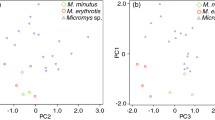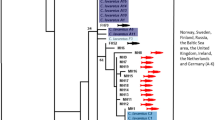Abstract
The family Mugilidae (Pisces, Mugiliformes) includes species which are present in all tropical and temperate regions. Six species, Chelon labrosus, Mugil cephalus, Liza aurata, L. ramada, L. saliens, Oedalechilus labeo, are commonly found in the Mediterranean. These species have been widely studied through morphological, biochemical, and molecular markers. However, their phylogenetic relationships, and therefore the assumed monophyly of Liza species, still remain unclear. To further investigate this topic, gene–enzyme systems and sequences of the partial 16S rRNA mitochondrial gene were analyzed in Italian samples of all six Mediterranean species. The phylogenetic reconstructions indicated M. cephalus as being the most divergent species and the existence of a main cluster including all the Mediterranean species of Liza and C. labrosus. The parametric bootstrap approach adopted to test alternative phylogenetic hypotheses indicated that the Mediterranean species of Liza do not form a monophyletic group exclusive of Chelon.
Similar content being viewed by others
REFERENCES
Bakke, I., and Johansen, S. (2002). Characterization of mitochondrial ribosomal RNA genes in Gadiformes: Sequence variations, secondary structural features, and phylogenetic implications. Mol. Phylogenet. Evol. 25:87–100.
Boyer, S. H., Faine, D. C. R., and Watson-Williams, E. J. (1963). Lactate dehydrogenase variant from human blood: Evidence for molecular subunits. Science 141:642–643.
Caldara, F., Bargelloni, L., Ostellari, L., Penzo, E., Colombo, L., and Patarnello, T. (1996). Molecular phylogeny of grey mullets based on mitochondrial DNA sequence analysis: Evidence of differential rate of evolution at the intrafamily level. Mol. Phylogenet. Evol. 6:416–424.
Clayton, J. W., and Tretiak, D. N. (1972). Amine-citrate buffers for pH control in starch gel electrophoresis. J. Fish. Res. Bd. Can. 29:1169–1172.
Cornuet, J. M., Piry, S., Luikart, G., Estoup, A., and Solignac, M. (1999). New methods employing multilocus genotypes to select or exclude populations as origins of individuals. Genetics 153:989–2000.
Crother, B. I. (1990). Is "some better than none" or do allele frequencies contain phylogenetically useful information? Cladistics 6:277–281.
De Rijk, P., Robrecht, E., de Hoog, S., Caers, A., Van der Peer, Y., and DeWachter, R. (1999). Database on the structure of large subunit ribosomal RNA. Nucleic Acids Res. 27:174–178.
Emerson, B. C., Ibrahim, K. M., and Hewitt, G. M. (2001). Selection of evolutionary models for phylogenetic hypothesis testing using parametric methods. J. Evol. Biol. 14:620–631.
Emerson, B. C., Oromi, P., and Hewitt, G.M. (2000). Interpreting colonization of the Calathus(Coleoptera: Carabidae) on the Canary islands and Madeira through the application of the parametric bootstrap. Evolution 54:2081–2090.
Felsenstein, J. (1993). PHYLIP(Phylogeny Inference Package), Version 3.5C, University of Washington, Seattle, WA.
Fisher,W. (1973). FAO species identification sheets for fishery purposes. In Mediterranean and Black Sea, Vol. I, Food and Agriculture Organization of the United Nations, Rome.
Gornung, E., Cordisco, C. A., Rossi, A. R., De Innocentiis, S., Crosetti, D., and Sola, L. (2001). Chromosomal evolution in Mugilidae: Karyotype characterization of Liza saliensand comparative localization of major and minor ribosomal genes in the six Mediterranean mullets. Mar. Biol. 139:55–60.
Harrison, I. J., and Howes, G. J. (1991). The pharyngobranchial organ of mugilid fishes; its structure, variability, ontogeny, possible function and taxonomic utility. Bull. Br. Mus. Nat. Hist. (Zool.) 57:111–132.
Hillis, D. M., and Bull, J. J. (1993). An empirical test for bootstrapping as a method for assessing confidence in phylogenetic analysis. Syst. Biol. 42:182–192.
Huelsenbeck, J. P., Hillis, D. M., and Jones, R. (1996). Parametric bootstrapping in molecular phylogenetics: Applications and performance. In Ferraris, J. D., and Palumbi, S. R. (eds.), Molecular Zoology: Advances, Strategies, and Protocols, Wiley-Liss, New York, pp. 19–45.
Johansen, S., and Bakke, I. (1996). The complete mitochondrial DNA sequence of Atlantic cod (Gadus morhua): Relevances to taxonomic studies among codfishes. Mol. Mar. Biol. Biotech. 5:203–214.
Lee, S. C., Chang, J. T., and Tsu, Y. Y. (1995). Genetic relationships of four Taiwan mullets (Pisces: Perciformes: Mugilidae). J. Fish Biol. 46:159–162.
Louis, E. J., and Dempster, E. R. (1987). An exact test for Hardy-Weinberg and multiple alleles. Biometrics 43:805–811.
Loytynoja, A., and Milinkovitch, M. C. (2001). SOAP, cleaning multiple alignments from unstable blocks. Bioinformatics 17:573–574.
Lutzoni, F., Wagner, P., Reeb, V., and Zoller, S. (2000). Integrating ambiguously aligned regions of DNA sequences in phylogenetic analyses without violating positional homology. Syst. Biol. 49:628–651.
Nei, M. (1972). Genetic distances between populations. Am. Nat. 106:283–292.
Nei, M. (1978). Estimation of average heterozygosity and genetic distance from a small number of individuals. Genetics(Austin) 89:583–590.
Nelson, J. S. (1994). Fishes of the World, 3rd edn. John Wiley and Sons, New York.
Orti, G., and Meyer, A. (1997). The radiation of Characiform fishes and the limits of the resolution of mitochondrial ribosomal DNA sequences. Syst. Biol. 46:75–100.
Paetkau, D., Calvert, W., Sterling, I., and Strobeck, C. (1995). Microsatellite analysis of population structure in Canadian polar bears. Mol. Ecol. 4:347–354.
Palumbi, S. R. (1996). Nucleic Acids II: The polymerase chain reaction. In Hillis, D. M., Moriz, C., and Mable, B. K. (eds.), Molecular Systematics, Sinauer, Sunderland, MA, pp. 205–247.
Papasotiropoulos, V., Klossa-Kilia, E., Kilias, G., and Alahiotis, S. (2001). Genetic divergence and phylogenetic relationships in grey mullets (Teleostei: Mugilidae) using allozyme data. Biochem. Genet. 39:155–168.
Papasotiropoulos, V., Klossa-Kilia, E., Kilias, G., and Alahiotis, S. (2002). Genetic divergence and phylogenetic relationships in grey mullets (Teleostei: Mugilidae) based on PCR-RFLP analysis of mt-DNA segments. Biochem. Genet. 40:71–86.
Popov, A. M. (1930). Mullets of Europe (Mugilidae) with description of a new species from the Pacific Ocean. Trudy Sevastopol'. Biol. Sta. 2:47–125.
Posada, D., and Crandall, K. A. (1998). MODELTEST: Testing the model of DNA substitution. Bioinformatics 14:817–818.
Rambaut, A., and Grassly, N. C. (1997). Seq-Gen: An applications for the Monte Carlo simulation of DNA sequence evolution along phylogenetic trees. Comp. Appl. Biosciences 13:235–238.
Rice, W. R. (1989). Analysing tables of statistical tests. Evolution 43:223–225.
Ridgway, G. J., Sherburne, S. W., and Lewis, R. D. (1970). Polymorphism in the esterases of Atlantic herring. Trans. Am. Fish. Soc. 99:147–151.
Rosenblatt, R. H., and Waples, R. S. (1986). A genetic comparison of allopatric populations of the fish species from the eastern and central Pacific Ocean: Dispersal or vicariance? Copeia 1986:275–284.
Rossi, A. R., Capula, M., Crosetti, D., Sola, L., and Campton, D. E. (1998a). Allozyme variation in global populations of striped mullet, Mugil cephalus(Pisces: Mugilidae). Mar. Biol. 131:203–212.
Rossi, A. R., Capula, M., Crosetti, D., Campton, D. E., and Sola, L. (1998b). Genetic divergence and phylogenetic inferences in five species of Mugilidae (Pisces: Perciformes). Mar. Biol. 131:213–218.
Schultz, L. P. (1946). A revision of the genera of mullet, fishes of the family Mugilidae with the descriptions of three new genera. Proc. U.S. Natl. Mus. 96:377–395.
Senou, H., Randall, J. E., and Okiyama, M. (1996). Chelon persicus, a new species of mullet (Perciformes: Mugilidae) from the Persian Gulf. Bull Kanagawa Prefect. Mus. (Nat. Sci.) 25:71–76.
Shaklee, J. B., Allendorf, F. W., Morizot, D. C., and Whitt, G. S. (1990). Gene nomenclature for protein-coding loci in fish. Trans. Am. Fish. Soc. 119:2–15.
Siciliano, M. J., and Shaw, C. R. (1976). Separation and visualisation of enzymes on gels. In Smith, I.(ed.), Chromatographic and Electrophoretic Techniques. Zone electrophoresis, Vol. II, Year Book Medical Publishers, Chicago, pp. 185–209.
Swofford, D. L. (1998). PAUP*. Phylogenetic Analysis UsingParsimony(*and Other Methods),Version 4.0b3, Sinauer, Sunderland, MA.
Tamura, K., and Nei, M. (1993). Estimation of the number of nucleotide substitutions in the control region of mitochondrial DNA in humans and chimpanzees. Mol. Biol. Evol. 10:512–526.
Thomson, J. M. (1997). The Mugilidae of the world. Mem. Queensl. Mus. 41:457–562.
Tortonese, E. (1975). Osteichthyes (Pesci Ossei). In Fauna d'Italia:, Vol. XI, Calderini, Bologna, Italy, pp. 11–26.
Trewavas, E., and Ingham, S. E. (1972). A key to the species of Mugilidae (Pisces) in the Northeastern Atlantic and Mediterranean, with explanatory notes. J. Zool. Lond. 167:15–29.
Author information
Authors and Affiliations
Corresponding author
Rights and permissions
About this article
Cite this article
Rossi, A.R., Ungaro, A., De Innocentiis, S. et al. Phylogenetic Analysis of Mediterranean Mugilids by Allozymes and 16S mt-rRNA Genes Investigation: Are the Mediterranean Species of Liza Monophyletic?. Biochem Genet 42, 301–315 (2004). https://doi.org/10.1023/B:BIGI.0000039806.12756.81
Issue Date:
DOI: https://doi.org/10.1023/B:BIGI.0000039806.12756.81




